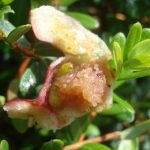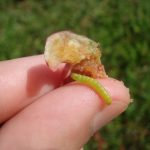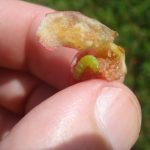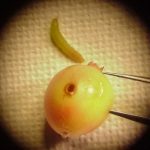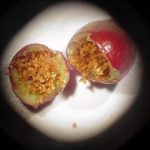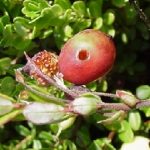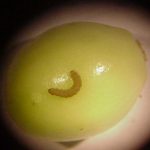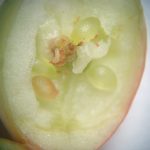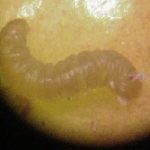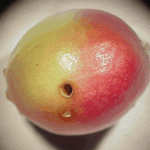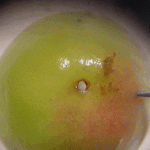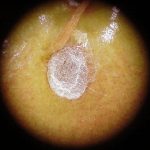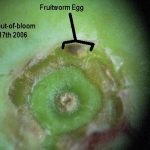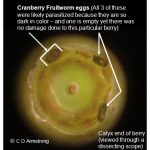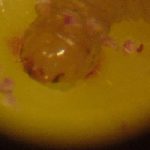Cranberry Fruitworm
- A cranberry that has been split open, revealing a Cranberry fruitworm larva and its droppings/frass inside
- Another view of a cranberry that has been split open, and a Cranberry fruitworm larva and its droppings/frass
- Closer view of a cranberry that has been split open, revealing a Cranberry Fruitworm larva and its droppings/frass inside
- A Cranberry fruitworm larva and the cranberry from which it was removed
- A cranberry that has been split open, revealing a Cranberry fruitworm larva and its droppings/frass inside
- Two cranberries destroyed by Cranberry fruitworm
- A Cranberry fruitworm larva crawling on the outside of a green/unripe cranberry
- An early instar cranberry fruitworm larva inside a cranberry – 8/4/2016
- Magnified view of a cranberry fruitworm larva (viewed through a dissecting scope)
- A cranberry with both a visible entrance hole and an exit hole created by a Cranberry fruitworm larva (entrance hole is the smaller one, covered over with white silk webbing to protect the larva inside)
- Entrance hole in the side of a green cranberry, and covered over with silken webbing to protect the larva inside
- Closeup view (seen through a dissecting scope) of a cranberry fruitworm’s entrance hole that has been covered over with silken webbing in order to keep out any potential predators
- A Cranberry fruitworm egg, nestled securely into the calyx end of its cranberry host
- Three cranberry fruitworm eggs, and most likely all 3 have been parasitized because they are all dark in color (and because one of them is empty and yet there was no damage done to the berry)
- Close view of the head of a Cranberry fruitworm larva as it feeds on a cranberry
photos by C. Armstrong
Life Cycle:
Eggs: The Cranberry Fruitworm is a serious cranberry pest that deposits a total of approximately 50 eggs, singly*, in the calyx end–or blossom end (bottom end)–of berries while the berries are still green (moths will actively search for berries that are pea-sized or larger to oviposit on, and a bloom stage referred to as 50% out-of-bloom helps with predicting the start of the egg-laying period, and thus the timing of control measures). As they near hatch, the eggs develop an irregular orange streak. It is nearly impossible to see the eggs without a magnifying lens of some kind. *Rarely does another moth deposit an egg on a berry that already has an egg present, but once in awhile you may find a berry with 3 or 4 eggs deposited on it.
Larvae: As obvious from the photos above, the damaging stage of the cranberry fruitworm is the larval stage. Fruitworm larvae are very small and pale yellow-green upon hatching. The larvae begin to emerge from the eggs after just three to five days and then most often they will crawl ‘up’ from the calyx end to the stem end of the berry (sometimes they tunnel into the calyx end). They then burrow their way into the berry, close the entrance hole with silk, and begin feeding on the berry’s contents with voracious appetite. They feed from mid-July through September, and during that time, each larva will typically move from one berry to another, hollowing out a total of three to eight berries. Berries that have been severely hollowed out will often have an exit hole that is considerably larger than the original entrance hole, as the larva increases greatly in size as it feeds, of course, and must thus chew its way out if it expects to locate another berry. The injured berries turn red prematurely, wrinkle and wither, and are commonly referred to as ‘raisins’. When mature, the fruitworm larva reaches nearly an inch in length and becomes bright green with a reddish tinge along the dorsal (top) portion of its body.
Adults / Moths: Adult moths are active during calm evenings from June through early August. During the day they generally stay hidden among the cranberry vines, but at night, there is evidence suggesting that they prefer to move to nearby trees for mating, and then return to the cranberry beds by morning. Moths have been known to fly considerable distances in a single flight (270′ to 0.3 miles or more). Description: The front wings are gray-brown with two very small, dark dots near the front margin. There are also two white markings, one toward the base of the front wings and the other one around the middle of the front margin. The hind wings are also gray-brown.
Control [Proper management should limit losses to less than 3 percent of the fruit]:
Control measures are most reliable when timed to a particular bloom stage referred to as 50% out-of-bloom. Relatively recent (2009) work in Massachusetts has resulted in some slight revisions to the spray timings they are recommending (at least for growers in that state) surrounding the 50% out-of-bloom stage. When 50% out-of-bloom is reached, the conventional practice in the past was to apply a pesticide application 3-5 days later for Stevens, 5-7 days later for Ben Lears, and 7-9 days later for Early Black and Howes. The shifted, UMass recommendation now is that for early varieties, especially Stevens, the first spray should be timed for the same time as the 50% out-of-bloom date. However, this is challenging since honey bees and other native bees are still foraging at that time, so pollinator-friendly materials should be given heavy consideration as being a better choice under those circumstances. Intrepid® and Altacor®, for example, are two choices for a product that can be applied right at the 50% out-of-bloom stage, for all varieties.
Additional Treatments? If you are unable to monitor eggs, use the following guidelines:
- 2nd application 10-11 days after the first;
- 3rd application may be needed during years of VERY high fruitworm populations, 10-11 days after the 2nd application; Two sprays seem to be plenty adequate for growers in Maine, however, and sometimes only one is needed.
Preferably, monitor eggs to trigger sprays (Difficult, however, without significant magnification, preferably a dissecting scope):
Five days after the first treatment, inspect 50 randomly-picked berries per acre (with a minimum of 200 berries per single, large piece). Follow the guidelines in the table below to determine if a spray is warranted. If egg numbers trigger a spray, spray as soon as possible. Otherwise, repeat the berry inspection process every 3-4 days until the egg-laying time has passed (around Aug. 20th). If fruitworm pressure is low through fruit set, it may be safe to extend intervals between berry sampling dates.
Table Recommended (for all practices) to Determine Necessity of Additional Spraying for Cranberry Fruitworm:
| Number of Acres | Number of Berries Checked | Number of Viable Eggs Needed to Trigger Spray during profitable berry prices |
Number of Viable Eggs Needed to Trigger Spray during very low berry prices (< $0.30 per lb.) |
|---|---|---|---|
| 0-5 | 200-250 | 1 | 2 |
| 6 or 7 | 251-350 | 2 | 4 |
| 8 or 9 | 351-450 | 3 | 6 |
| 10 or 11 | 451-550 | 4 | 8 |
| for each additional 2 acres | add 100 berries | add 1 egg | double the number determined at left |
The management practice of using a ‘Late-Water Flood’ [Late-Water Flood (pdf) | Late-Water Flood (MS Word)] will more than likely greatly reduce fruitworm pressure. If you’ve held Late Water, it is possible that sprays can be eliminated for cranberry fruitworm during the Late-Water year, but berries should still be monitored for eggs throughout the fruitworm season as the moths are very mobile and may move into your bed from external sources—namely, from stands of wild cranberries.
For the most current control recommendations for Maine, please refer to the Maine Cranberry Pest Management Guide.

